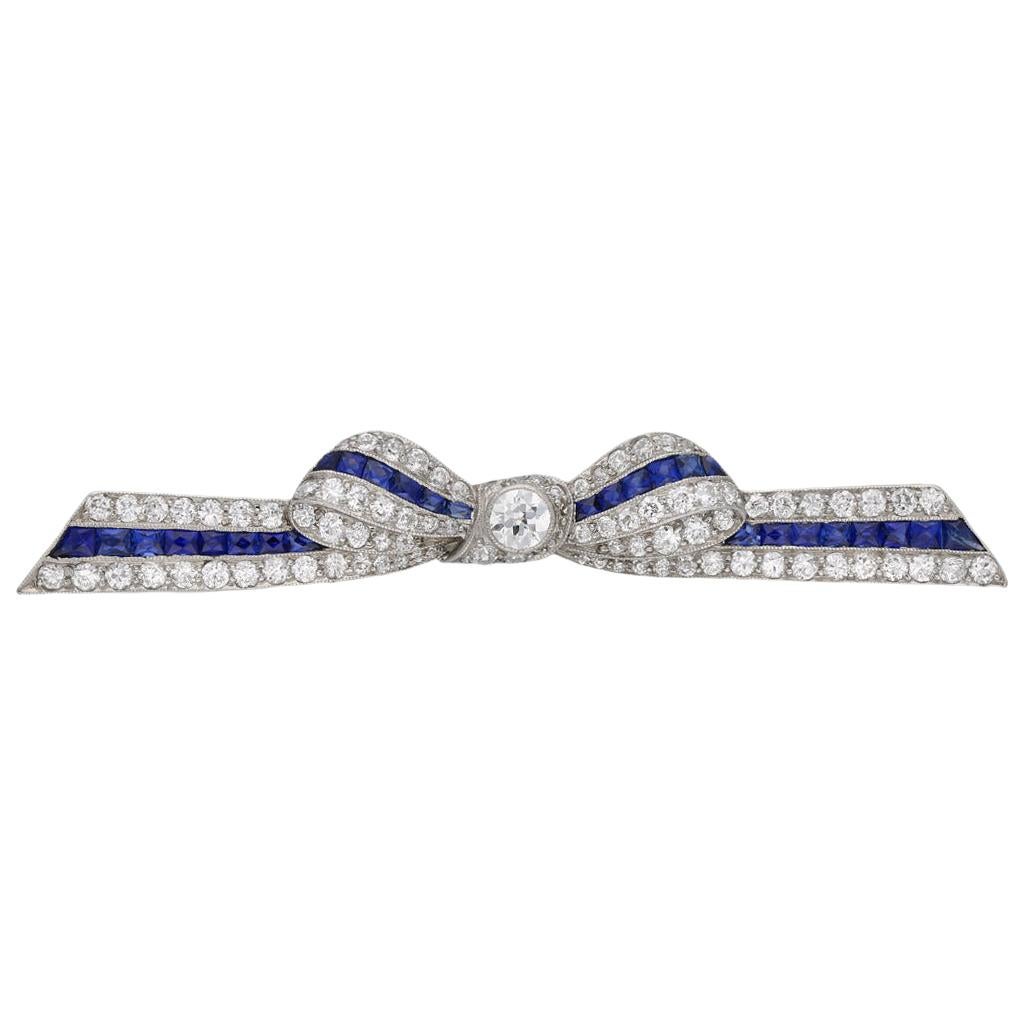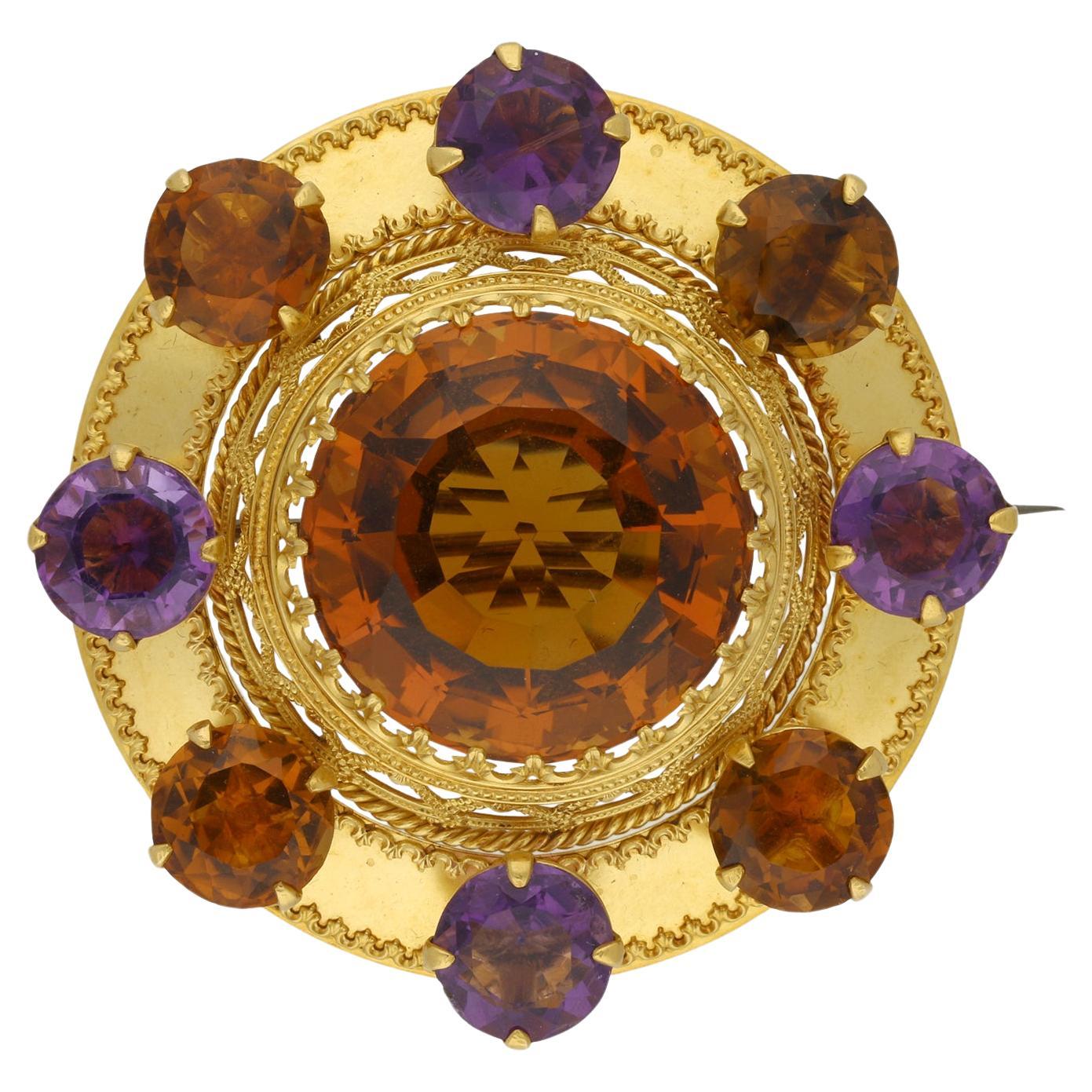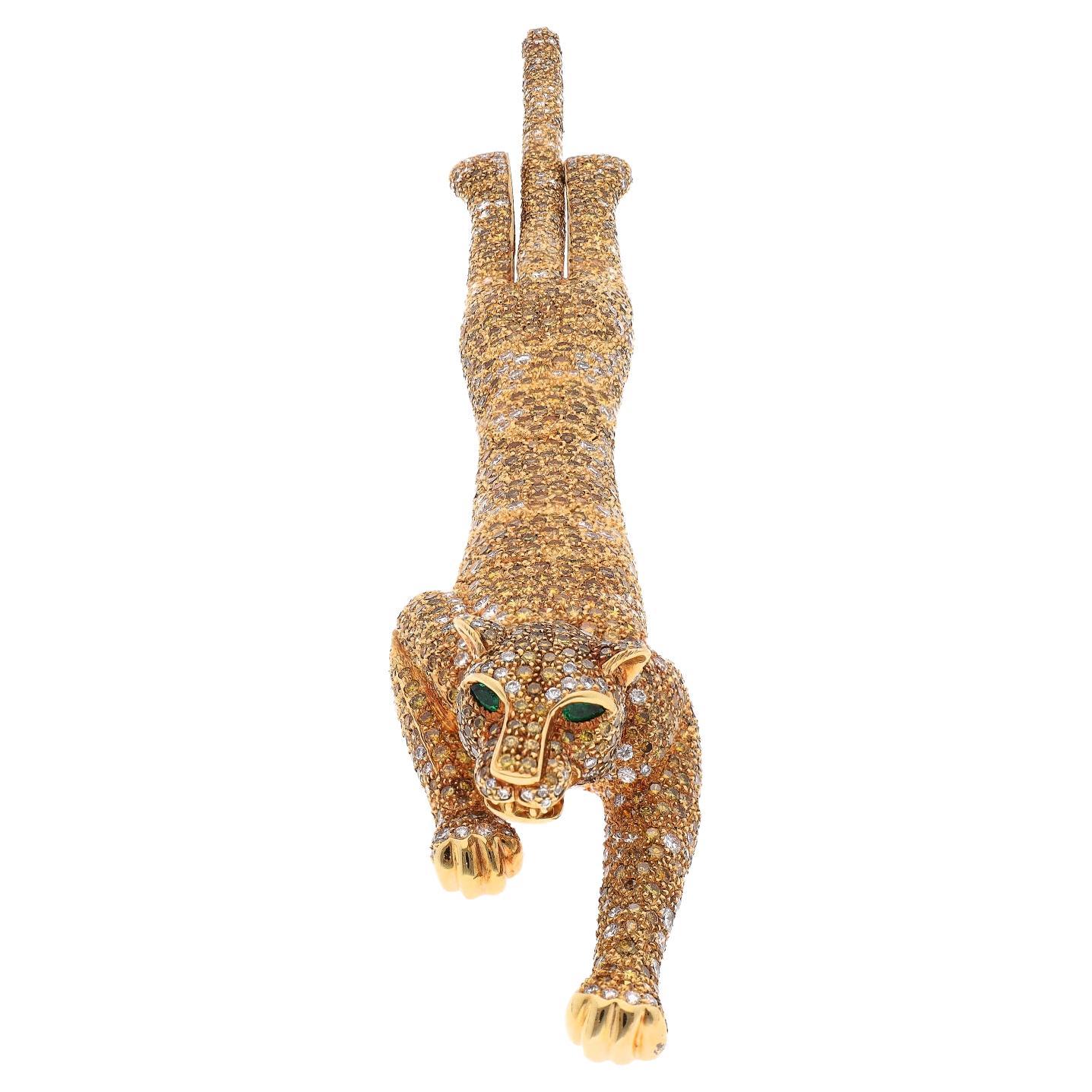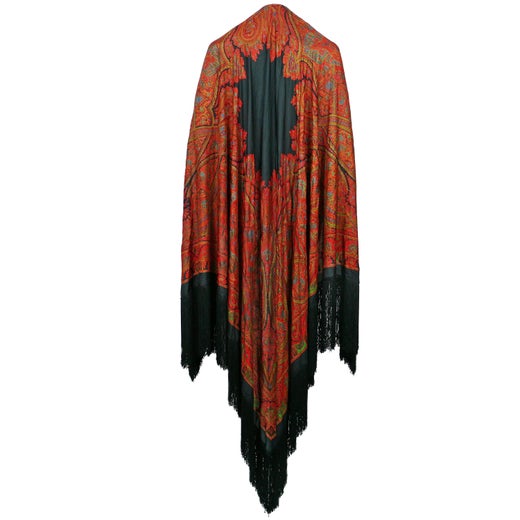Yves Saint Laurent Brooch in Gold and Silver Plated Heart with Rhinestones
About the Item
- Creator:
- Metal:Gilt Metal
- Dimensions:Height: 2.17 in (55 mm)Width: 2.05 in (52 mm)
- Place of Origin:France
- Period:1980-1989
- Date of Manufacture:Circa 1988
- Condition:
- Seller Location:SAINT-OUEN-SUR-SEINE, FR
- Reference Number:
Yves Saint Laurent
French designer Yves Saint Laurent pioneered “cross-design” in fashion, taking inspiration from street trends to modernize haute couture.
Saint Laurent was the first to launch a ready-to-wear label, YSL Rive Gauche Prêt-à-Porter. He was the first couturier to open boutiques for both men and women. Using traditional menswear fabrics and designs for women, Saint Laurent also literally cross-dressed, giving men and women alike chic pant suits, elegant tuxedo jackets and urban safari gear.
By blurring gender-specific design, Saint Laurent empowered individual style while creating a scissor-sharp fashion aesthetic of sensual ease and beauty. Many of his designs are today considered timeless classics. Saint Laurent also consistently used Black models, like Mounia, Iman and Naomi Campbell, and he drew endless inspiration from different ethnicities and cultures, in no small part because of his Algerian roots.
Born to French parents in Oran, Algeria, in 1936, Saint Laurent went to Paris at age 17 to study fashion at the Chambre Syndicale de la Haute Couture. Just two years later, in 1955, his remarkable sketches were shown to Christian Dior, then the world’s reigning couturier, who hired him immediately.
Surprisingly soon thereafter, Dior publicly chose Saint Laurent as his successor, which sadly proved prescient when the fashion legend died unexpectedly, in 1957. A mere slip of a youth, the 21-year-old Saint Laurent was nevertheless up to the challenge. He shook the traditional couture clientele to its core with youthful silhouettes and styles like the A-line trapeze dress that hung with seeming effortlessness from the shoulders, the antithesis of the pinched waists and molded skirts that had been all the rage after the deprivations of World War II.
After a mandated spell in the torturous French military, Saint Laurent suffered a nervous breakdown and was dismissed by Dior in 1962. Out of the ashes rose the Age of Yves. With Pierre Bergé, his then-lover who became his lifelong business partner and friend, the designer founded Yves Saint Laurent YSL to encompass prêt-à-porter, or ready-to-wear. In 1966, they opened the first YSL Rive Gauche women’s boutique in Paris, followed soon thereafter by YSL Rive Gauche for men. Saint Laurent had given birth to a global brand.
His revolutionary Mondrian mini dress from 1965 is a core element of his fashion biography. It is a prime example of how Saint Laurent, an avid art lover and collector, looked to painters, from Goya to Picasso, Ingres to Matisse, for inspiration.
With its pure lines and hues, Mondrian’s ground-breaking 1935 color-block painting Composition C transmutes beautifully into a dress that is highly valued by collectors of contemporary fashion and widely copied commercially to this day. The design is the epitome of Saint Laurent’s aesthetic, requiring a meticulous hand-piecing of each color block so that, despite the body’s curves, the visual plane is as flat as a canvas when the garment is worn. Mondrian’s purity met its match in Saint Laurent.
“I am no longer concerned with sensation and innovation, but with the perfection of my style,” Saint Laurent said four years before retiring, in 2002. After a long period of ill health, he died at his home in Paris on June 1, 2008.
Browse an extraordinary collection of vintage Yves Saint Laurent evening dresses, shirts, handbags and other clothing and accessories today on 1stDibs.

- ShippingRetrieving quote...Ships From: SAINT-OUEN-SUR-SEINE, France
- Return PolicyThis item cannot be returned.
- Christian Dior Golden Metal Brooch Paved with RhinestonesBy Christian DiorLocated in SAINT-OUEN-SUR-SEINE, FRDior -Golden metal brooch paved with rhinestones. Additional information: Dimensions: 6 L cm Condition: Very good condition Seller Ref number: BR133Category
1990s French Brooches
MaterialsGilt Metal
- Dior Golden Metal BroochBy Christian DiorLocated in SAINT-OUEN-SUR-SEINE, FRDior -Gold metal brooch. Additional information: Dimensions: 7 W x 3.3 H cm Condition: Very good condition Seller Ref number: BR134Category
1990s French Brooches
MaterialsGilt Metal
- Dior Round Brooch in Gilded Metal and Glass Paste CabochonsBy Christian DiorLocated in SAINT-OUEN-SUR-SEINE, FRDIOR - (Made in Germany) Round brooch in gilded metal and glass paste cabochons. 1967 collection. Additional information: Dimensions: Diameter: 4.5 cm Condition: Very good condition...Category
Vintage 1960s German Brooches
MaterialsGilt Metal
- Dior Haute Couture "Butterfly" Brooch, 1970sBy Christian DiorLocated in SAINT-OUEN-SUR-SEINE, FRYves Saint Laurent - Haute Couture brooch featuring an openwork silver butterfly paved with rhinestones. Jewel made by Maison Gripoix for Dior Haute Couture, unsigned. Collection 197...Category
Vintage 1970s French Brooches
- Chanel Brooch in Silver Plate, 1996By Karl Lagerfeld for ChanelLocated in SAINT-OUEN-SUR-SEINE, FRChanel (Made in France) Brooch in silver plate, rhinestones, and glass paste. 1996 Spring-Summer Collection Additional information: Dimensions: 7.5 cm x 7.5 cm (2.95" x 2.95") Co...Category
1990s French Brooches
MaterialsSilver Plate
- Christian Dior Silver Plated Metal Brooch with Imposing RhinestonesBy Christian DiorLocated in SAINT-OUEN-SUR-SEINE, FRDior - Silver plated metal brooch with imposing rhinestones. Additional information: Dimensions: 10 H cm Condition: Very good condition Seller Ref number: BR154Category
1990s French Brooches
MaterialsSilver Plate
- Vintage Ruby Onyx and Diamond Classic Car BroochLocated in London, GBHere we have a superb vintage brooch. The piece has been crafted from 18ct yellow gold into the shape of a classic car from the 1930s. Automobiles of the 1930s exhibited many notable...Category
Vintage 1930s Brooches
MaterialsDiamond, Onyx, Ruby, Gold, Yellow Gold, Enamel
- Marcus & Co. Sapphire and Diamond Bow Brooch, American, circa 1935Located in London, GBSapphire and diamond bow brooch by Marcus & Co, American, circa 1935. A yellow gold and platinum bow form brooch set with one central row of twenty eig...Category
Vintage 1930s American Art Deco Brooches
MaterialsDiamond, Sapphire, Platinum
- John Brogden Shell Cameo Brooch and Earrings, English, circa 1870By John BrogdenLocated in London, GBAntique shell cameo brooch and earrings by John Brogden, English, circa 1870. A yellow gold suite of jewellery, the brooch composed of a horizontally situated oval Bull’s Mouth shell cameo of the Greek goddess Selene riding a serpentine dragon in a rubover collet setting, encircled by a conforming frame of gold beading and twisted gold wire punctuated with four gold palmette form plaques engraved and decorated with dark blue enamel and placed at the cardinal points, the reverse mounted with a hinged pin and scroll clasp, the earrings each composed of a vertical oval Bull’s Mouth shell cameo engraved with a bust length portrait of Selene with crescent-set headdress, encircled by a conforming frame matching that of the brooch with the addition of a pendant decoration composed of a horizontal bar of gold beading and twisted gold wires suspending gold link chains graduated from centre and ending in conical gold elements, the reverses mounted with French wire fittings, all in a fitted red leather case, the interior marked ‘FIRST CLASS PARIS MEDAL/ 1855.1867.1851/ PARIS FIRST CLASS & LONDON PRIZE MEDALS/ JOHN BROGDON/ Goldsmith/ MANUFACTORY/ 16, Henrietta St. Covent Garden/ London’. The cameo—defined as a gem, usually either a mineral or a shell, upon which a design has been carved in relief—is believed to have originated in Hellenistic Greece, during the third century BC. These miniature sculptures, at that time confined to the medium of hardstone, are thought to have been made with the primary purpose of personal adornment. The same practice of mounting cameos in jewellery was then continued by the Ancient Romans, and they are known to have been worn by many a Roman emperor. After the fall of Rome the fashion for cameos went into a decline, until it was again revived during the Renaissance period, brought about by a keen interest in the ancient world. At this time both antique and contemporary cameos were mounted in jewellery, as well as collected as objet d’art. The art of cameo cutting was revived in Italy, where it would remain a centre for the coming centuries. Again there was a lull in interest in carved gemstones, until the Neoclassical revival of the eighteenth century, largely stimulated by the discoveries of the ancient Roman cities of Pompeii and Herculaneum. As with the Renaissance, antique specimens were generally prized over modern cameos, and the worldliest men in Europe held them among their collections of art and antiques. That said, carving centres in Rome and Torre del Greco (near Naples) in Italy were established in response to the demand of the Grand Tourists, who travelled to Italy and Greece to become educated in the wonders of the ancient world. It was at this time that shell cameos, mostly made in Torre del Greco due to its proximity to the sea, became more popular, owing to the relative ease in carving shell over hardstone. In addition to Rome, hardstone cameos also became a specialty of Idar Oberstein, Germany, which had a long history with both the gem mining and cutting trade. In a shift away from the collector’s cases of the previous century, the nineteenth century saw a strengthening in the fashion for wearable cameos. After the Empress Josephine donned a cameo-set suite of jewellery at the coronation of Napoleon in 1804, cameo jewellery became all the rage. Napoleon played a further hand in promoting the art by establishing a gemstone carving school in Paris, inspired by his appreciation for the arts of the ancient world. By the mid-nineteenth century shell cameos, in part due to their lightness compared with hardstone cameos, were the height of fashion. Large shell cameos as well as hardstone cameos were set into contemporary mounts, often as suites of jewellery. Some of the best cameos of the nineteenth century—carved by a select group of recognized carvers—were set into revivalist mounts, corresponding to the subject matter. In Victorian England cameo jewellery was particularly prized, due in part to the fact that the Queen owned and wore a number of cameo jewels. One example which can often be seen in official portraits is the Badge of the Order of Victoria and Albert, carved by Tommaso Saulini of Rome, who also produced cameos for the maker of the present suite, John Brogden. To meet demand some carvers set themselves up in London, including William Schmidt, a German carver from Idar Oberstein, who produced cameos for top London jewellers, including Brogden, Carlo Giuliano and Child & Child. In fact, Schmidt purports to have been the first to carve cameos out of opal, which Brogden reportedly displayed in the Paris Exhibition of 1878. An extant example, now in the collection of the British Museum, was set by the Giuliano firm. Regarding subject matter, cameos throughout time have been largely figural, from bust length profile portraits to scenes with multiple full-length figures, and sometimes animals. Ancient Greek and Roman cameos often depicted mythological scenes as well as contemporary figures. During the Renaissance, mythological scenes were popular, often taken directly from ancient sculpture, as well as portraits of notable contemporary figures. During the eighteenth and nineteenth centuries, due to the revivalist styles, both Renaissance and Classical subjects were copied and set into matching (and sometimes unmatching) revivalist mounts. From the Renaissance through the Victorian era, being able to recognize the source of the carving in a cameo was a mark of erudition, revealing in the wearer knowledge of Classical art. As mentioned, the present cameo parure...Category
Antique 1870s English Victorian Brooches
MaterialsYellow Gold
- Victorian amethyst and citrine brooch, circa 1860.Located in London, GBVictorian amethyst and citrine brooch. Set to centre with one round old cut citrine in an open back claw setting with an approximate weight of 60 carats, encircled by four round old ...Category
Antique 1860s Brooches
MaterialsAmethyst, Citrine, Yellow Gold
- Ruby and diamond brooch, circa 1945.Located in London, GBRuby and diamond brooch. Set to centre with thirty four square baguette cut natural unenhanced rubies in open back channel settings with a combined approximate weight of 3.40 carats,...Category
Vintage 1940s Brooches
MaterialsDiamond, Ruby, Yellow Gold, Platinum
- Cartier Paris Yellow Cognac White Diamond Panther BroochBy CartierLocated in New York, NYCartier Paris Yellow Cognac White Diamond Panther Brooch Cartier describes the Panther as 'The Panther is Cartier’s iconic animal: a wild, untamable anim...Category
2010s French Modern Brooches
MaterialsWhite Diamond, 18k Gold
Recently Viewed
View AllRead More
How to Spot a Fake YSL Bag
Counterfeiters know that savvy fashionistas cherish YSL bags. Learn how to tell if yours is the real deal. Of course, you don't have to worry about that on 1stDibs, where every seller is highly vetted.
Quiet Luxury May Be Trending, but These Famous Interiors Prove That Quality and Quirk Endure
Because truly timeless design requires personal vision, transcendent taste, real fortitude and top-notch objects, even if the wider world hasn’t caught on yet.






